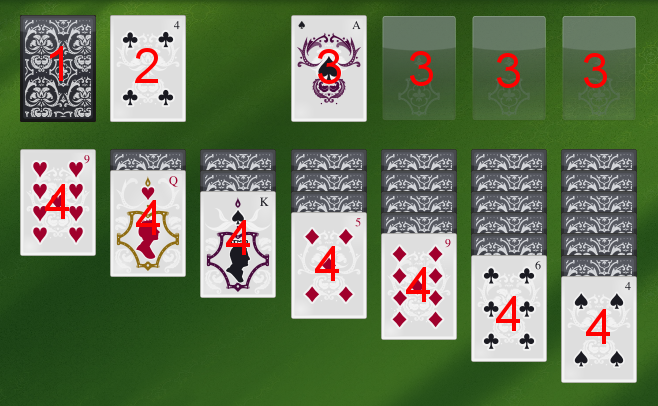Table of Contents
A card game contains one or more card decks of 52 cards each. Each deck contains the four suits:
 | Clubs |
 | Spades |
 | Hearts |
 | Diamonds |
Each of these suits contains the following card types: ace, two, three, four, five, six, seven, eight, nine, ten, jack, queen, and king.
This complete order of cards is called a family. There are real families and alternating ones. The real families are all of one suit (e.g. Hearts). In the alternating families the card color changes from one to another, between a black color (Clubs and Spades) and a red color (Hearts and Diamonds).
If the family is not complete it is called a sequence.

There are a number of features found in typical patience games. These are described below.
- 1. Talon
At the beginning of each game all cards are mixed in the deck. In some games not all cards are dealt out. The remaining cards are put down on the talon (also called the stock). You can find this quite easily, since in most games it is the only pile in which all cards are face down.
- 2. Waste Pile
Many games use a waste pile to hold cards taken from the talon. Typically clicking on the talon will cause the topmost card to be flipped face up and placed on the waste pile, at which point the card enters play.
- 3. Foundation
The foundation piles are where you want your cards to end up. Typically, the game is won only once all cards have been moved to the foundation piles in the correct order. The number of foundation piles and the ordering required varies from game to game.
Most games start with the foundation piles empty. Choosing the action from the menu or toolbar will cause KPatience to scan through all the piles move as many cards to the foundation piles as it can. If you have the setting activated, KPatience will attempt to perform a drop whenever possible.
- 4. Playing Piles
These piles are those where the actual reordering happens. The rules for these piles vary a lot between games. Some show all cards on them, some do not. Some allow only one card to be removed, some allow every card to be removed, etc.